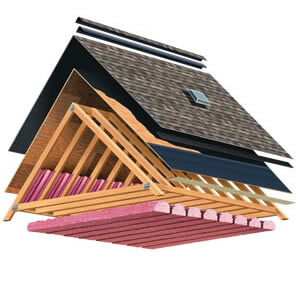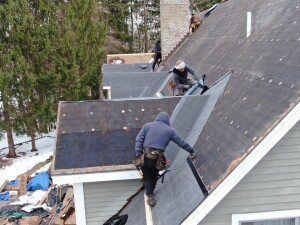Whenever we at Connecticut Roofcrafters install a new or replacement roof on a residence here in Connecticut, what we actually install is a roofing system. Roofing systems consist of four key elements: the structural framing of the roof, the roof sheathing – sometimes called decking, the underlayment and flashing, and then the most visible portion of the roof – the roofing material itself. In this blog post, we are going to focus on the underlayment and, specifically, what is called Ice and Water Shield. This is a type of underlayment used on a portion of or all of the roof decking and is designed specifically to protect the roof from water-based issues such as frost, ice, rain, and snow.
and flashing, and then the most visible portion of the roof – the roofing material itself. In this blog post, we are going to focus on the underlayment and, specifically, what is called Ice and Water Shield. This is a type of underlayment used on a portion of or all of the roof decking and is designed specifically to protect the roof from water-based issues such as frost, ice, rain, and snow.
Used under a variety of roofing materials including asphalt, architectural asphalt, wood, and slate or synthetic slate roofs, ice and water shield will effectively resist water penetration – especially in areas around vents, chimneys, skylights, and valleys which are especially prone to water intrusion. Anywhere water tends to collect and flow can be kept safe from damage by using an ice and water shield product.
Here in Connecticut, new building regulations require that “a minimum 4-inch-wide strip of self-adhering polymer-modified bitumen membrane … shall be applied over all joints in the roof decking.” You can learn more about this regulation here, but given this new policy, Connecticut Roofcrafters recommends that it is in the homeowner’s best interest to install self-adhering Ice and Water Shield continuously over the entire roof deck.
All ice and water shield products function in the same general way. They keep water from seeping under your roof and doing damage to your roof deck, attic, or the interior of your home. Ice and water shield can be used in new home construction and on re-roofing projects. The product works exceptionally well in both applications. As referenced above, in many locales, the installation of the shield is required by building codes. The product can be installed over the entire roof for extra protection but in many instances, it is only applied where problems generally occur.Ice & Water Shield on a Deep River Cedar Job
There is a wide variety of product types in the category of ice and water shield. In general, all of these products have a modified bitumen adhesive back surface that is covered by a release film. The film is removed during application so that the membrane will adhere to the roof deck and form watertight end laps and side laps when properly applied. The modified bitumen is designed to form a watertight seal around the nail penetrations when shingles are applied. Depending on the job, application, and budget, we recommend Ice and Water Shield products from CertainTeed WinterGuard, GAF WeatherWatch, and Grace Ice & Water Shield.
The integrity of your roof is of prime importance in homeownership. Water seeping under shingles and other types of roofing can cause great damage to the roof itself and anything under the roof, such as your attic and the interior of your home. Keeping the area dry is the best and easiest way to avoid such damage. A roofing underlayment system such as an ice and water shield is the most effective way to protect your roof and home.
Do you have more questions about how ice and water shield can improve the integrity of your roof? Would you like to schedule a roofing inspection? Contact us today to schedule an in-person evaluation of your roof. If it’s an emergency, call us on 1 (203) 745-5028.

